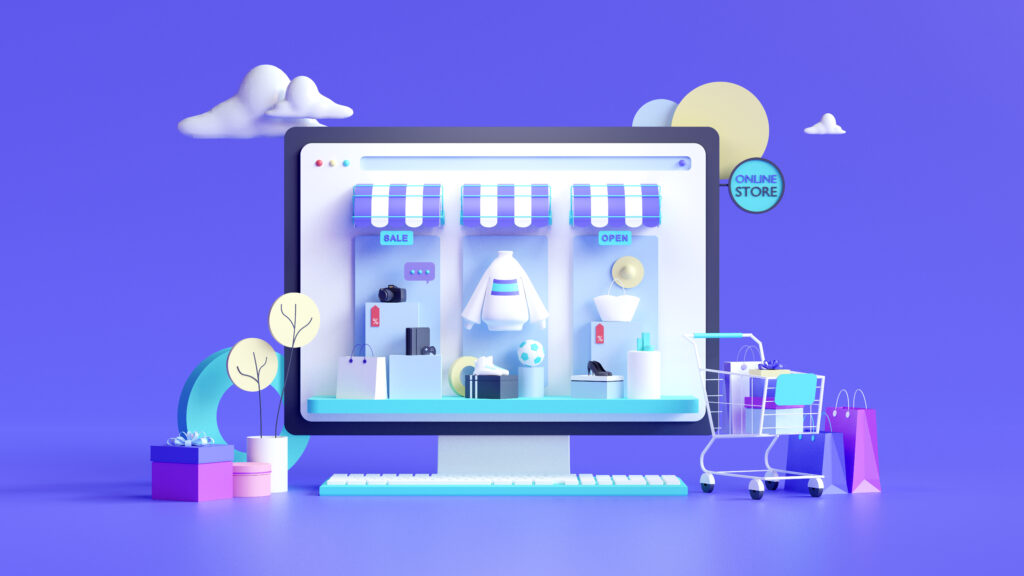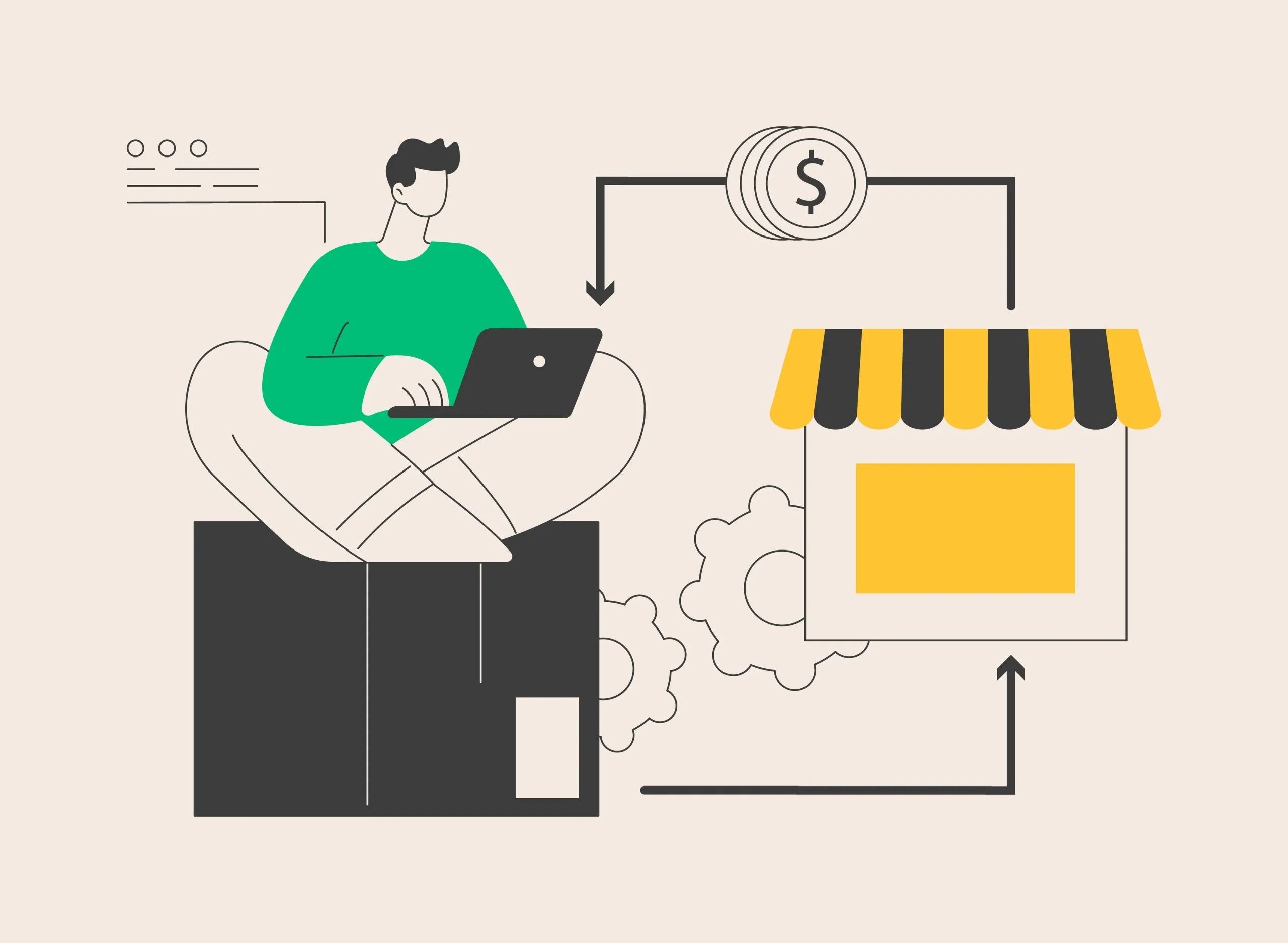The world of e-commerce has fundamentally transformed our shopping habits and the way we conduct business. Today, setting up an e-commerce business has become relatively easy for everyone. With the rapid growth of e-commerce, many industry-specific terms have emerged. If you’re new to the e-commerce world and want to learn more, this article is perfect for you! This comprehensive guide will answer all your questions about e-commerce. Here are the most common e-commerce terms you’ll want to know!

What is a Domain?
A domain is a cornerstone of the internet and can be considered the identity of a website. This concept was created to make accessing websites easy and memorable. When connecting to a website, you’re actually linking to complex IP addresses in the background. However, the lengthy and intricate nature of these addresses makes them difficult to remember. This is where domains come in; they provide easily remembered and expressed names in place of complex IP addresses.
A domain is the name you see in a website’s address bar, often with extensions like “.com” or “.net.” Each domain is unique, much like a fingerprint, and belongs to only one website. No two different websites can share the same domain name. This uniqueness allows internet users to easily find and remember websites.
Without the concept of domains, users would have to use long and complex IP addresses to access a website, making the internet much harder to use. Domains eliminate this complexity, making the internet more accessible and user-friendly. When a domain name is entered, the Domain Name System (DNS) translates it into the corresponding IP address, allowing access to the website.
Domains help maintain an organized and structured internet. Each domain points to the unique location of a website online. In the ever-growing world of the internet, domains play a crucial role as the identity and address of websites. That’s why choosing an appropriate and memorable domain when creating a website is a critical step for the success of your digital presence. When you look at the top of this website, you’ll notice that “ficommerce.com” is the domain address of this site.
What Are the Types of Domains?
Domain types are fundamental elements of the internet and are categorized into various groups. Let’s explore the different types of domains and their meanings!
Top-Level Domains (TLDs)
Top-Level Domains are the final part of a website’s address and typically reflect the purpose or location of the site. They are divided into two main categories:
Generic Top-Level Domains (gTLD): This category includes the most commonly used domain extensions, such as .com, .org, and .net. These domains are widely chosen for general purposes by businesses, organizations, and individual users.
Country Code Top-Level Domains (ccTLD): Each country has its own two-letter domain extension. For example, .tr for Turkey, .de for Germany, and .jp for Japan. These domains are typically used for websites associated with a specific country.
Second-Level Domains (SLDs)
Second-Level Domains are located just below a TLD and typically represent a brand or company name. For example, in the address ‘example.com,’ ‘example’ is the SLD. These domains are important for adding uniqueness to websites and making them easily recognizable.
Third-Level Domains
Third-Level Domains are found to the left of the SLD and are often known as subdomains. These domains are useful for large, segmented websites. For example, in ‘blog.example.com,’ ‘blog’ is a Third-Level Domain.
Brand Top-Level Domains (Brand TLDs)
Brand Top-Level Domains allow companies to use their brand names as domain extensions. This is particularly beneficial for businesses looking to enhance brand recognition and customize their online presence.
The domain world is continuously evolving, offering new ways to utilize domains. Entrepreneurs and companies can creatively use ccTLDs, which represent geographic locations, to create unique web addresses.
As one of the fundamental building blocks of the internet, domains play a critical role in defining a website’s identity. This variety showcases the ever-changing and dynamic nature of the internet. Each type of domain is designed to meet different needs of websites, reflecting the vast and diverse nature of the web.
Things to Consider When Buying a Domain
Choosing the right domain is a crucial decision, especially for e-commerce and digital businesses. Here are some key points to keep in mind during this process:
- If you are a commercial business, it is generally beneficial to choose the preferred and well-known “.com” extension. This extension is important for both reliability and international recognition.
- Make sure your domain name is short and easy to remember. Long or complex domain names can be difficult for potential visitors to remember.
- The domain name you choose should be simple in terms of both spelling and pronunciation. This makes it easier for users to access your website.
- Using keywords related to your business or the services you offer in your domain name can be beneficial for SEO (Search Engine Optimization).
- A unique and brandable domain name contributes to strengthening your brand identity. Try to choose a distinctive name to differentiate yourself from competitors.
- Consider your future expansions and ensure your domain name is suitable for these expansions.
- Avoid using hyphens in your domain name. Such symbols can lead to spelling confusion for users.
- Conduct thorough research to ensure the domain name you choose has not been taken before.
- Avoid consecutive double letters in your domain name to prevent spelling errors.
- When registering your domain, prefer reliable and well-known domain registrars.
- Make sure to align your domain with the web hosting company you will be using. In some cases, hosting packages may include a free domain.
- Consider the quality of customer service offered by the domain registrar. Good customer service provides quick and effective solutions to potential problems.
- Extra features like private domain registration and privacy policies can be important factors in your decision.
- Once you find the ideal domain name, quickly complete the purchase.
Choosing a domain name is the first step into the digital world, and this choice will shape your business’s online identity. By managing this process carefully and thoughtfully, you can set your brand off to a great start on its journey to online success. The right domain choice will be one of the most important elements that define you and your business in the digital world.
What is Hosting?
For websites to exist continuously in the digital world, a strong technological infrastructure is necessary. The cornerstone of this infrastructure is known as “hosting.” So, what is hosting, and why is it so important for a website?
A website consists of digital files that are always accessible on the internet. These files can include various content such as texts, images, and videos. Hosting refers to the platform where these files are stored and managed online. Simply put, hosting is like the digital home of a website.
First and foremost, since a website needs to be accessible at all times, hosting services operate on special computers (web servers) that are always running. Unlike the computers in our homes, these servers have high-speed internet connections and large bandwidth. This ensures that websites can reach visitors from anywhere in the world quickly and without interruption.
Another important aspect is security and resilience. Hosting providers house their servers in special facilities called data centers. These facilities are built to withstand natural disasters and are equipped with backup systems to prevent power outages. This allows websites to remain online even during natural disasters or technical issues.
Hosting also involves the technical maintenance and management of websites. This allows website owners to update their content, monitor visitor traffic, and even manage email services without dealing with technical details.
The success of a website largely depends on the quality of its hosting service. A reliable, fast, and constantly accessible hosting service is the foundation for establishing a strong presence in the digital world. Therefore, when creating a website, choosing the right hosting service is crucial for site owners.
What are the types of hosting?
Websites and applications rely on hosting services to maintain their presence in the digital world. Various types of hosting cater to different needs and technological requirements. So, what are these hosting types, and what are they used for? Let’s explore the most common hosting types and their features:
Linux Hosting: Ideal for those seeking open-source solutions and flexibility. It is based on the Linux operating system and is compatible with technologies like CGI, Perl, MySQL, and PHP. It is often preferred for popular content management systems like WordPress, as these systems run more efficiently on Linux-based servers.
Windows Hosting: Perfect for sites compatible with Microsoft technologies such as ASP and .NET Framework. It is based on the Windows operating system and integrates with databases like Access and MSSQL. This type is particularly ideal for Microsoft-based applications.
E-Commerce Hosting: Designed for online stores and commercial websites. It offers e-commerce-specific tools such as SSL certificates, shopping cart software, and payment processing systems. It is developed to optimize security and user experience.
WordPress Hosting: Specifically optimized for WordPress-based sites. It typically comes with WordPress pre-installed and includes additional themes and applications. It offers automatic updates and SSD storage, providing advantages in speed and security.
Web Hosting: Allows you to publish your websites and applications online. It operates on secure and continuously accessible servers. It comes with additional features such as email hosting, page builders, and SSL certificates to meet the needs of site owners and visitors.
Reseller Hosting: Allows users to host multiple websites under their account or sell hosting services. This type is commonly preferred by small hosting companies, web designers, and entrepreneurs.
Mail Hosting: Suitable for businesses with heavy email traffic. It focuses on email management and can handle high volumes seamlessly, but it does not offer website hosting functionality.
Each type of hosting is tailored to specific needs and technological preferences. Whether it’s a personal blog or a large e-commerce site, choosing the right hosting is crucial to the success of your online presence. The key is to select the hosting type that best suits your needs and to position yourself correctly in the e-commerce world.
What should be considered before purchasing hosting?
We have compiled what you should consider when choosing web hosting. We recommend reviewing these details just before making your selection to find the most suitable hosting solution for your needs. Here are the details:
1- Be Aware of Additional Costs
Hosting plans may include additional costs if you exceed the monthly traffic limit. Such situations should be clearly outlined in the service agreement. Also, be mindful of hidden costs that may arise during domain name transfers.
2- Pay Attention to Domain Ownership
Some hosting companies may register the domain name under their own name instead of yours. Make sure the domain is actually registered in your name.
3- Technical Support is Important
Especially if you are new to web hosting, it’s crucial that your provider has a strong technical support team. A good support team can offer quick and effective solutions whenever you encounter any issues.
4- Don’t Overlook Server Speed
Speed is a crucial factor for visitor experience and site success. Check if the hosting provider has server hardware and SSD disk technology.
5- Physical Location Matters
The physical location of your hosting provider can affect your website’s loading speed. Choosing a hosting provider located close to your visitors can enhance your site speed.
6- Bandwidth and Storage Space
Choose a hosting plan that offers bandwidth and storage space suited to your website’s needs. Keep in mind that even plans labeled as “unlimited” may have some limitations.
7- Choose an Upgradable Plan
Select a hosting plan that aligns with your website’s growth potential. A plan that can be easily upgraded as your needs change will provide you with flexibility in the long run.
8- Pay Attention to Uptime
It’s important for your website to be online and accessible most of the time. Choose hosting providers that offer high uptime rates.
9- Research Security Measures
To ensure the security of your website, choose a hosting provider that prioritizes security measures. Opt for a provider that has the capabilities to assist you in case of security issues.
By considering these criteria, you can select the most suitable hosting service for your website. It’s always important to conduct thorough research and carefully read the service terms offered by your provider.
What is an SSL Certificate?
An SSL certificate is considered a fundamental element for navigating the secure corridors of the internet. Various web platforms, especially e-commerce sites, use these certificates to protect their visitors’ and customers’ data. SSL establishes a secure connection between a website and its users, ensuring that information is transmitted in an encrypted form. As the importance of security in online transactions increases, an SSL certificate has become an essential requirement.
An SSL certificate not only verifies the identity of the website but also ensures that the information entered by users is transmitted in an encrypted form. This process means that the data is encrypted in such a way that it can only be accessed with the correct key. As a result, internet users can safely send their information to web servers.
The certificate includes details such as the name of the certificate holder, the serial number, and the expiration date. It also contains a copy of the certificate holder’s public key and the digital signature of the issuing authority.
These certificates are typically valid for one or two years and must be renewed upon expiration. For e-commerce sites, in particular, an SSL certificate is crucial for both increasing customer trust and meeting the security standards of payment systems and banks. The padlock symbol you see on websites indicates that the site is protected by an SSL certificate and is a sign that the site is secure.
The SSL certificate is a vital security measure that ensures the safe exchange of information over the internet, critical for both website owners and users. These certificates ensure that transactions carried out in the digital environment are conducted securely.

What is a Bundle Product?
In the world of e-commerce, many strategies exist to enrich the shopping experience for customers and boost sales. One such strategy that has gained popularity in recent years is “bundle” products. So, what is a bundle product, and why is it important for businesses?
A bundle is a sales method that offers different products as a single package. This approach typically involves offering complementary or compatible products together. For example, selling a smartphone along with compatible headphones and a charger as a package can be considered a bundle product. The main goal here is to provide more value to customers, encouraging them to purchase multiple products at once.
The benefits of bundling are varied for both businesses and consumers. For businesses, it offers the opportunity to sell off inventory more quickly and increase sales figures. It also provides a chance to strengthen brand loyalty through attractive offers aimed at customers. For consumers, bundle packages are often more affordable than purchasing the products individually, offering a cost-effective shopping experience. Additionally, it simplifies the shopping process for customers and saves them time.
Moreover, the presentation of bundle products, particularly on e-commerce platforms, can be personalized. Creating customized packages based on customer needs and preferences can enhance the customer experience and increase sales potential. This positively impacts both customer satisfaction and business revenue.
Bundle products are an effective marketing and sales strategy in e-commerce. They simplify inventory management, increase sales, and strengthen customer relationships for businesses, while offering a cost-effective and time-saving shopping experience for consumers.

What is Headless E-commerce?
Headless E-commerce is a revolutionary approach in the digital commerce space. In this approach, the visible part of the e-commerce platform (frontend) is designed independently from the backend operations. This separation increases flexibility and customization options, bringing the user experience to the forefront.
First, let’s clarify the concepts of frontend and backend. The frontend refers to the visual interface of the website that users interact with directly. Elements such as buttons, animations, fonts, and site design are part of this area. It functions like the storefront of an e-commerce site, forming the foundation of the customer experience. On the other hand, the backend is responsible for technical details like the server, database, and application management.
The security, speed, and data processing capabilities of the e-commerce site are shaped in this area. The backend ensures that the processes on the site run smoothly, a process that is usually invisible to the user.
In headless e-commerce, these two areas are separated, creating a more flexible structure. For example, when changing the site design, there is no need to modify the backend. This accelerates the development process and creates a more agile structure.
In this system, APIs (Application Programming Interfaces) play a crucial role. When users interact with the frontend elements of the e-commerce site, such as adding a product to the cart, information is sent to the backend via an API. This information is processed, and the necessary responses are sent back to the frontend based on the user’s request.
Headless e-commerce marks a new era in digital commerce by offering more freedom and flexibility to e-commerce sites. This approach has become an ideal solution for e-commerce platforms that want to improve user experience and keep up with technological advancements.
What are the advantages of Headless E-commerce?
Headless E-commerce offers an innovative approach that keeps pace with the speed of the digital world. This system enables e-commerce platforms to be more dynamic, flexible, and user-friendly, helping businesses enhance their success in the digital space. Here are the main advantages of Headless E-commerce:
- Headless e-commerce allows for complete customization of the interface design, enabling brands to create unique sites that reflect their identity.
- Changes made on the frontend can be implemented quickly and easily, independent of the backend code. This allows for a rapid response to sudden market changes or user needs.
- Effective A/B testing can be conducted, making it easier to optimize user experience and increase conversion rates by experimenting with various design templates.
- It offers multi-platform compatibility, ensuring a seamless experience across both desktop and mobile devices, providing a consistent experience for all users.
- Advanced API integrations make more comprehensive and integrated e-commerce solutions possible.
Headless e-Commerce plays a significant role in the digital transformation process of businesses. With its flexibility and customizable structure, it strengthens brands’ digital presence and enhances the user experience. This innovative system is an ideal solution for any business looking to gain a competitive advantage in the e-commerce world and adapt to ever-changing market conditions.
What is Q-Commerce?
Q-commerce, or “Quick commerce,” is an innovative e-commerce model that responds to the fast-paced, always-connected demands of today’s consumers. This model particularly aims to enhance speed and efficiency in online shopping and delivery services. Q-commerce stands out with deliveries often completed in less than an hour, offering convenience that attracts customers.
At its core, Q-commerce focuses on meeting customers’ urgent needs, especially for essential products like food and medicine, in the shortest time possible. Unlike traditional e-commerce, it emphasizes the local shopping experience by partnering with local suppliers. This approach provides customers with not only a fast but also a more personalized and local shopping experience.
Q-commerce is gaining increasing popularity in our digitalizing world. The success of this model depends on flexible and rapid logistics systems. For e-commerce brands, the key to implementing Q-commerce lies in developing effective logistics and distribution strategies. This allows brands to enhance customer satisfaction while optimizing their business processes.
By aligning with today’s fast-paced lifestyle, Q-commerce saves consumers time and improves their quality of life. The convenience and speed it offers are set to play a significant role in the future of e-commerce.

What is a Call to Action (CTA)?
A key strategy for websites, the term “Call to Action” (CTA) refers to a series of elements designed to guide, influence, and ultimately convert visitors into customers. CTAs typically appear as buttons, images, text, or web links.
A CTA on a website is a message that prompts visitors to take a desired action. It can be used in various areas such as blog posts, category descriptions, and product pages, and can be highlighted through different designs. The primary goal of a CTA is to influence the user and encourage them to take immediate action.
CTAs play a critical role in the marketing communication process. These messages directly reach consumers and are used to drive them towards making a purchase decision. As part of marketing strategies, CTAs help a site achieve its objectives, increase engagement, and ultimately attract more customers. Therefore, CTAs are indispensable tools for e-commerce sites and play a key role in engaging with users.
What is Search Engine Optimization (SEO)?
Search Engine Optimization (SEO) refers to a series of strategic actions aimed at increasing an e-commerce site’s online visibility and optimizing its ranking in accordance with search engine rules. These optimization efforts help the website appear higher in search results. SEO makes the site easier for search engines to crawl, understand, and highlight in search results when targeted keywords are searched.
E-commerce SEO specifically involves SEO practices tailored for e-commerce sites. This comprehensive strategy helps e-commerce platforms stand out in the competitive online market. These efforts include a range of elements, from choosing the right e-commerce infrastructure and selecting keywords to optimizing categories, products, and brand descriptions, building backlinks, and ensuring visual optimization and mobile compatibility. E-commerce SEO enables businesses to more effectively reach their target audience, increase organic traffic, and gain long-term competitive advantages. It provides measurable results, helping businesses make more informed decisions about their investments.
What is Cross Selling?
Cross Selling is a sales strategy that involves recommending similar or complementary products to customers based on their current purchase. For example, if a customer buys a smartphone from an e-commerce site, cross selling might involve offering related products like a charging cable at the same time. Cross selling is a tactic used to introduce additional products that can be associated with and enhance the items customers have already decided to purchase.
For businesses, cross selling is an effective way to increase sales by encouraging existing customers to make additional purchases. The products recommended to customers are carefully selected to meet their needs and encourage them to spend more during the purchase process. This strategy is used to improve the customer’s shopping experience and offer them more value.
Cross selling offers businesses the opportunity to increase sales with lower costs while enriching the shopping experience for customers by providing more options. This method is applied by salespeople effectively introducing and associating products to encourage customers to add more items to their purchase.
What is Outsource?
Outsource refers to the practice of obtaining a service or product from a different company that specializes in a particular area, rather than producing it in-house. This can be applied in various fields such as e-commerce logistics, webshop software, customer service, and more. By using outsourcing, companies can reduce production, personnel, and operating costs, thereby increasing operational efficiency. This approach provides companies with greater flexibility, as they can source specialized services according to their needs.
Outsourcing also allows businesses to work with suppliers and customers worldwide, offering a competitive advantage in global markets. Additionally, outsourcing gives companies the opportunity to focus more by transferring heavy workloads and responsibilities to an external provider. As a new business model, outsourcing has evolved and become a strategic advantage for many companies. Outsourcing helps businesses operate more effectively and efficiently, allowing them to gain a competitive edge.
What is E-Mail Marketing?
E-mail marketing is an effective digital marketing method that involves sending specially designed emails with links to existing or potential customers. It aims to deliver information, promotions, offers, and celebration content to the target audience through electronic mail. E-mail marketing is a fundamental marketing channel for brands of nearly every sector and scale.
This marketing strategy stands out among digital marketing channels in terms of return on investment (ROI) and engagement. It has the potential to increase the desired impact by delivering the right message to the right person at the right time. E-mail marketing is a powerful tool for directly communicating with existing and potential customers, boosting conversions, strengthening customer loyalty, and enhancing brand image.
By sharing special offers, updates, and information with customers via email, you can build trust with potential customers, strengthen your brand image, and establish long-term customer relationships. E-mail marketing is an effective strategy for businesses to attract customers, drive engagement, and increase sales.
What is Marketplace Integration?
Marketplace integration is a crucial tool used by businesses operating on e-commerce marketplaces to ensure seamless data flow and integration between their own e-commerce sites and these marketplaces. E-commerce marketplaces are online platforms that bring together sellers and buyers. Through marketplace integrations, businesses can more effectively manage their sales, order processes, and e-commerce operations.
Marketplace integrations offer various advantages to businesses. These integrations allow sellers to open stores, list products, and manage inventory on marketplaces more quickly and efficiently. They also ensure consistency across stores on different marketplaces, helping businesses keep their product information up-to-date and accurate.
As an indispensable tool for e-commerce sites, marketplace integration enables businesses to gain a competitive advantage and reach a broader customer base across multiple marketplaces. This allows businesses to grow more rapidly and implement their online sales strategies more effectively.
This is where fiCommerce comes into play. With its experience in e-commerce, fiCommerce offers marketplace integrations, giving brands the opportunity to establish a strong presence on marketplaces. fiCommerce provides fulfillment services tailored to brands operating in or entering the e-commerce sector. By taking timely and accurate actions in accordance with marketplace policies in product listing, order, return, and cancellation processes, it aims to enhance store performance for brands.
What is Dropshipping?
Dropshipping is a business strategy in the e-commerce world that adopts a stockless sales model. This model allows businesses to operate without holding inventory or maintaining a warehouse. An e-commerce site showcases products and manages sales and marketing processes. When a customer purchases a product, the e-commerce site forwards the order to the supplier, who then ships the product directly to the customer.
Dropshipping acts as a bridge between the customer and the seller. The customer orders the product from the seller, but the product is directly supplied and shipped by the supplier or manufacturer. In this process, sellers do not have to deal with tasks such as stocking, warehousing, or shipping. The revenue generated is shared between the seller and the supplier.
The dropshipping model offers flexibility and cost advantages to e-commerce businesses. Since businesses do not have to stock or warehouse their products, they can offer a wider range of products. Additionally, operating costs are reduced, as expenses related to inventory and warehousing are eliminated. In this way, dropshipping provides e-commerce businesses with the opportunity to reach a broader customer base with less risk.

What is an Electronic Payment System?
An electronic payment system is a technology that simplifies shopping and payment processes in today’s rapidly digitalizing world. This system enables payments for products or services to be made in a virtual environment between buyers and sellers who are not physically present in the same location. Electronic payments are made over the internet using tools like credit cards, debit cards, virtual cards, and e-checks. This method offers a faster and more secure alternative compared to traditional payment methods.
Electronic payment systems are considered one of the fundamental components of e-commerce. Unlike shopping in a physical store, where the buyer and seller are in the same location, e-commerce requires that payment transactions be carried out through digital platforms. These systems play a critical role in online shopping processes, allowing companies to generate revenue from sales. Electronic payment methods provide users with the ability to save time, speed up transactions, and make payments securely.
Electronic payment systems have become an indispensable part of modern commerce, offering innovative solutions that simplify the shopping experience and enhance security. These systems significantly contribute to the growth of the e-commerce sector while also making daily life easier for users.
What are the advantages of electronic payment systems?
Electronic payment systems have become an indispensable part of e-commerce today. The advantages offered by these systems provide numerous conveniences not only for businesses but also for consumers. Here are some key advantages of electronic payment systems:
Electronic payment systems allow businesses to reach customers worldwide. This means the opportunity to target a wide customer base without geographical limitations.
- Payments can be completed in seconds with just a few clicks. This saves time for both customers and businesses, increasing efficiency.
- Payments can be made from anywhere, whether at home or on the go. This flexibility improves the shopping experience for customers.
- Payments can be processed in simple steps without requiring technical knowledge, allowing people of all ages and technological backgrounds to use the system.
- It is a safer method compared to carrying cash. Electronic transactions are protected by advanced security protocols and encryption.
- Electronic transactions minimize manual errors, increasing the accuracy and reliability of the transactions.
- Electronic payment systems enable faster and more efficient transactions, saving time and costs.
- They offer an eco-friendly alternative by reducing paper usage.
- They simplify the collection process, thereby speeding up cash flow for businesses.
- The recorded transaction feature enhances transparency.
Electronic payment systems are an indispensable tool for businesses in our time. These systems offer great convenience to both customers and businesses, enabling commerce to be conducted more efficiently and securely. For any business operating in the e-commerce sector, adopting electronic payment systems is a crucial step for ensuring customer satisfaction.

What is an E-Invoice?
An e-invoice is a type of invoice managed by the Revenue Administration and holds the same legal value as a traditional paper invoice. Prepared in electronic form, the e-invoice does not need to be printed on paper, and its printed form is considered invalid. As part of the government’s e-transformation process, it enables invoices to be created in a digital environment and facilitates communication between the buyer and seller through electronic servers.
While maintaining the official validity of traditional invoices, the e-invoice includes the information specified in the Tax Procedure Law. This digital invoice model is an application aimed at speeding up business processes and making tax management more efficient.
What is E-Retailing?
E-Retailing is a trade model where traditional retail is brought onto digital platforms, and products are sold to end users over the internet. E-commerce sites aim to reach customers online by sourcing and providing products and services. E-retailing, which can be defined as the online version of traditional retail, represents the digitized form of retailers who sell goods in small quantities to customers.
E-Retailing is a form of trade that can be considered within the scope of e-commerce, constituting a subset of this field. This model digitizes the shopping experience by offering various products and services to consumers online. As in traditional retail, the principle of selling goods individually or in small quantities to customers is also valid in e-retailing.
This trade model can reduce infrastructure costs by decreasing the need for physical stores. However, e-retailing may require infrastructure investments in areas such as shipping and warehousing after e-sales occur on e-commerce sites. For a successful e-retailing strategy, an attractive website, effective online marketing, and efficient product distribution are essential.
This guide, prepared for those taking their first steps into the world of e-commerce, will serve as a reference by providing the meanings of relevant terms! By guiding you in developing your business’s digital strategy, it can help you succeed in this dynamic sector. You can strengthen your business by using the right terms. Stay tuned to continue progressing confidently on this path that leads you to success in the e-commerce world!





